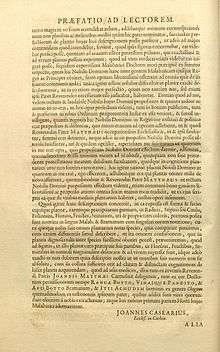Hortus Malabaricus

Hortus Malabaricus (meaning "Garden of Malabar") is a comprehensive treatise that deals with the medicinal plant properties of the flora of the Western Ghats region principally covering the areas now in the Indian states of Kerala, Karnataka and the union territory of Goa.
History
Written in Latin, it was compiled over a period of nearly 30 years and published in Amsterdam during 1678–1693.[1] The book was conceived by Hendrik van Rheede, who was the Governor of Dutch Malabar at the time. The book has been translated into English and Malayalam by K. S. Manilal and published by the University of Kerala.[2][3]

Description
The Hortus Malabaricus comprises 12 volumes of about 200 pages each, with 794 copper plate engravings. The first of the 12 volumes of the book was published in 1678, and the last in 1693. It is believed to be the earliest comprehensive printed work on the flora of Asia and the tropics.
Mentioned in these volumes are plants of the Malabar region which in his time referred to the stretch along the Western Ghats from Goa to Kanyakumari. The book gives a detailed account of the flora of Kerala, along with sketches and detailed descriptions. Over 742 different plants and their indigenous science are considered in the book. The book also employs a system of classification based on the traditions adopted by the practitioners of that region. Apart from Latin, the plant names have been recorded in other languages including Konkani, Arabic, English, and Malayalam.
The comprehensive nature of the book is noted by T. Whitehouse in his 1859 Historical Notices of Cochin on the Malabar Coast:[4]
All the country around was diligently searched by the natives best acquainted with the habitats of plants; and fresh specimens were brought to Cochin where the Carmelite Mathaeus sketched them, with such striking accuracy, that there was no difficulty in identifying each particular species when you see his drawings. Names of each species is written in Malayalam as well as Konkani (Then known as Brahmananchi Bhas) A description of each plant was written in Malayalam and thence translated into Portuguese, by a resident at Cochin, named Emmanuel Carneiro. The Secretary to Government, Herman Van Douep, further translated it into Latin, that the learned in all the countries of Europe might have access to it. The whole seems then to have passed under the supervision of another learned individual named Casearius, who was probably a Dutch Chaplain and a personal friend of Van Rheede. A book of its size, on which such care was expended, must have consumed a fortune before its publication, and confers honour, both on those who compiled it and the place where it was compiled.
Several species of plants have their type illustrations in this work.[5]

Contributors
Hendrik van Rheede is said to have taken a keen personal interest in the compilation of the Hortus Malabaricus. The work was edited by a team of nearly a hundred including:
- Physicians, such as Ranga Bhat, Vinayaka Pandit, Appu Bhat, and Itti Achuden.
- Professors of medicine and botany
- Amateur botanists, such as Arnold Seyn, Theodore Jansson of Almeloveen, Paul Hermann, Johannes Munnicks, Joannes Commelinus, Abraham a Poot.
- Technicians, illustrators and engravers, together with the collaboration of Dutch East India Company officials, and clergymen including D. John Caesarius and the Discalced Carmelite Mathaeus of St. Joseph’s Monastery at Varapuzha.
Van Rheede was also assisted by the King of Cochin and the ruling Zamorin of Calicut. Prominent among the Indian contributors were three Gouda Saraswat Brahmins (physicians) named Ranga Bhat, Vinayaka Pandit, Appu Bhat, and Malayali physician, Itti Achuden,[6] who was a Thiyya Vaidyan (Ayrvedic doctor) of the Mouton Coast of Malabar. The ethnomedical original information in the work was provided by these three working on it for two continuous years morning and evening as certified by them. Their certificate to this effect is given in the first volume of the book. A grand memorial to them is erected in Kochi.
Professor K. S. Manilal (b. 1938) has worked over 35 years on the research, translations, and annotations of the Hortus Malabaricus. The effort has brought the main contents of the book to Malayalam and English-speaking scholars. It had largely remained inaccessible previously to them, because of the entire text being untranslated into the English language and Malayalam language.[7]
See also
- Flora of Kerala
- Medicinal plant
- Plants used in Ayurveda
- Geography of Kerala
- History of Kerala
References
- ↑ Reede tot Drakestein, Hendrik van (1678–1703). Hortus Indicus Malabaricus :continens regni Malabarici apud Indos cereberrimi onmis generis plantas rariores, Latinas, Malabaricis, Arabicis, Brachmanum charactareibus hominibusque expressas ... (in Latin). Amstelaedami :sumptibus Johannis van Someren, et Joannis van Dyck. Retrieved 2008-09-09.
- ↑ "The University of Kerala brings out a Malayalam version of Hortus Malabaricus". Chennai, India: The Hindu. 2006-12-08. Retrieved 2006-12-23.
- ↑ "English reprinting of Hortus Malabaricus". Campus Jottings. Chennai, India: The Hindu. 2004-02-19. Retrieved 2006-12-23.
- ↑ rchive.org: Historical Notices of Cochin on the Malabar Coast; Reverend T. Whitehouse; Cottayam C M Press, Kerala; 1859.
- ↑ Majumdar, N. C.; Bakshi, D. N. Guha (1979). "A Few Linnaean Specific Names Typified by the Illustrations in Rheede's Hortus Indicus Malabaricus". Taxon. 28 (4): 353–354. doi:10.2307/1219745.
- ↑ Grove, Richard (Feb 1996). "Indigenous Knowledge and the Significance of South-West India for Portuguese and Dutch Constructions of Tropical Nature". Modern Asian Studies. 30 (1): 121–143. doi:10.1017/s0026749x00014104. JSTOR 312903.
- ↑ "Our first printed word". The Hindu. Retrieved 2006-12-23.
External links
| Wikimedia Commons has media related to Hortus Malabaricus. |
- Archive.org: Original Hortus Malabaricus text in digitized form
- Archive.org Review of references to Hortus Malabaricus
- Indiasocial.org: "325-year-old Dutch work on Kerala's plant wealth revived"
- Hindu.com: Malayalam version of Hortus Malabaricus
- Hindu.com: "Hortus Malabaricus' - a feather in the varsity's cap"
- "Memorial to Ranga Bhat Vinayak Pandit and Appu Bhat at Kochi"